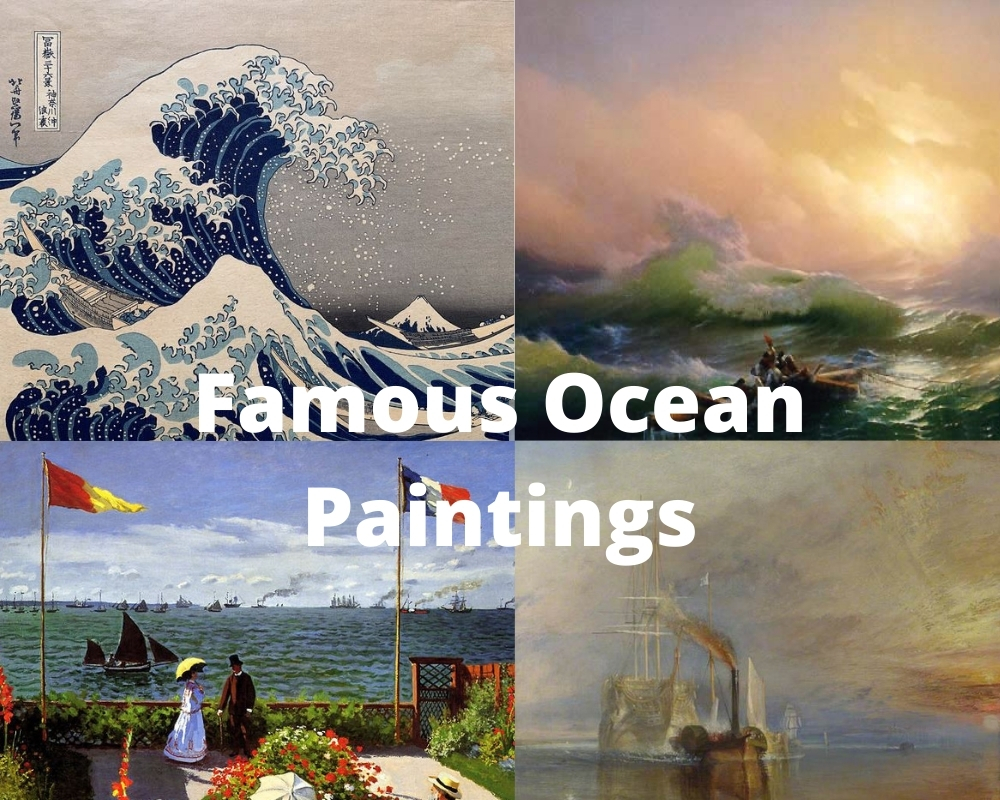The Ocean covers almost three-quarters of the Earth’s surface and has long been a central focus and source of inspiration for many of the most famous painters throughout history.
The ocean, like any other creature of a person, seems to have its own personality with characteristics like anger, excitement, calamity, gentleness, and other qualities.
Many great artists have sought to portray the ocean and how it interacts with the many different actions and decisions of mankind.
Capturing the sea in all it’s individualistic glory is a tall task for many painters, but the most skilled have found ways to portray the sea and it’s lofty waves in a manner which adds as much intrigue and amazement as any social dynamic that can be imagined by a playwright or other creative artist.
Painting the ocean has presented many different challenges in its own right. Some artists have found it most challenging to depict the calm, still water and its reflective properties while others have sought to show the sea in all its raging glory with giant, dangerous waves and boisterous winds.
Regardless of how the sea is portrayed, there is a significant level of mastery in being able to accurately depict the ocean in its many different forms. Here are 10 of the most famous ocean paintings ever done.
Famous Ocean Paintings
1. The Great Wave – Katsushika Hokusai
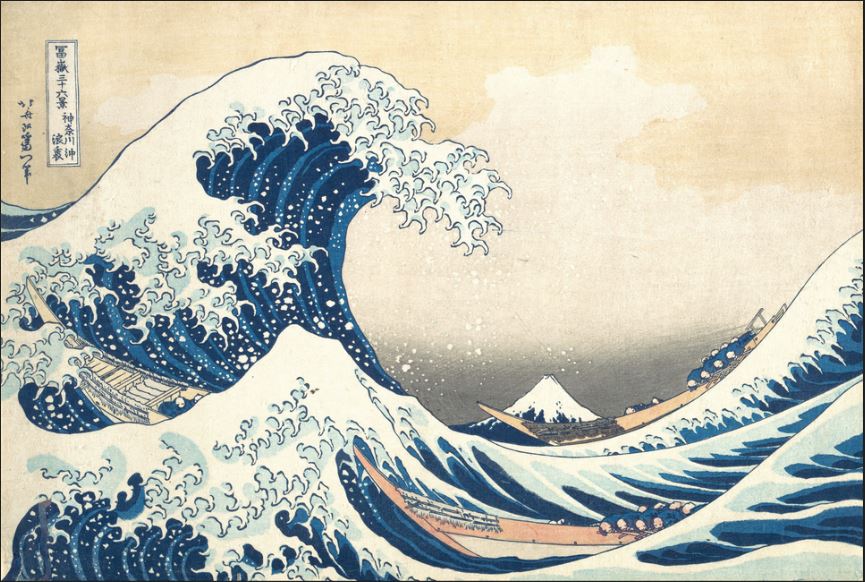
Painted in 1831, Katsushika Hokusai’s work titled The Wave was one that quickly garnered significant attention throughout the world despite Japan being under a strict period of isolation from much of the world.
This painting is also known as The Great Wave off Kanagawa and focuses completely on the unpredictable and often raging seas near Japan’s famous Mount Fuji.
Hokusai painted this work as a series of scenes he labeled Thirty-Six Views of Mount Fuji. This particular painting was the most famous as it depicted the ocean near Mount Fuji in all its famously unpredictable anger, which filled many sailors with an extreme sense of trepidation at having to sail near this area.
Hokusai chose to paint the work in a gripping blue coloration that mostly features the giant, roaring waves rising and crashing. Mount Fuji is actually visible in the crest of the largest wave as a small, distant landscape that can barely be distinguished from the rest of the ocean’s waves.
The mountain has a strange resemblance to the ocean waves in color, it’s snow-capped peak appearing much like the crest of the waves in the sea.
The artist also includes ships that are also dwarfed by the huge waves around them. The vessel that is in the center of the painting appears to be on the verge of being swallowed by an incoming rogue wave.
2. The Fighting Temeraire Tugged to her last Berth to be Broken Up – J.M.W Turner
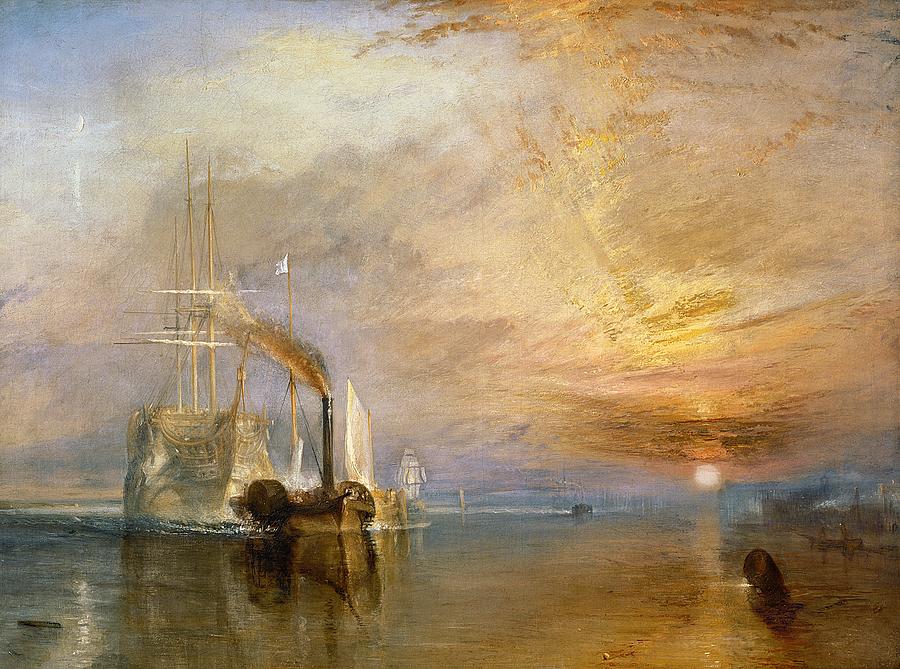
One of England’s most famous paintings is The Fighting Temeraire Tugged to her last Berth to be Broken Up by J.M.W Turner. This work depicts a point in time when sailed ships had begun to be rendered obsolete by steam and other powered ships that were able to cover distances faster and more efficiently.
Turner saw the fading beauty in this once-might warship’s final passage and painted a scene that lingers in the minds of many British art enthusiasts.
The old warship was known to have played a major role in the Battle of Trafalgar, which was a significant military encounter between the French and British naval forces during the Napoleanic Wars.
Also Read: Famous Ship Paintings
Turner paints the ship as being towed by a single, blackened tugboat as it is being dragged out to a scrapyard to be broken up and parted out.
The artist captures the symbolism of this warship in its former glory being overtaken by the newer, less attractive ship.
The stately HMS Temeraire is much larger than the tugboat and rises from the sea in an elegant manner that seems to fade into the misty background.
3. The Ninth Wave – Ivan Aivazovsky
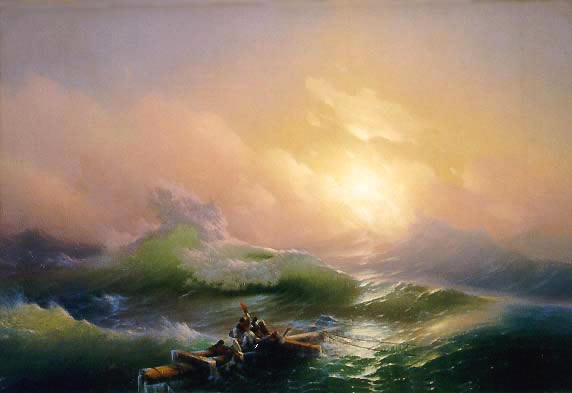
Few paintings have been able to capture the sheer realism of the ocean’s waves and their majestic variable forms that intertwine with the rising and setting sun.
Ivan Aivazovsky was one such artist who managed in 1850 to accurately portray the special beauty of the sea as three castaway sailors struggle to stay abreast of the raging waters.
Aivazovsky is well-known as an accomplished seascape painter and this work, titled The Ninth Wave, is widely considered to be his best.
The title is a reference to an old saying that many sailors believed to be factual that the largest wave would come after a succession of incrementally larger waves, in this case, the ninth.
The painting captures the rare splendor of the sun as it meets the horizon and plays along the ocean’s ever-changing surface. The work portrays the dual nature of the sea as both a beautiful sight to behold, and a destructive force of nature.
4. The Gulf Stream – Winslow Homer
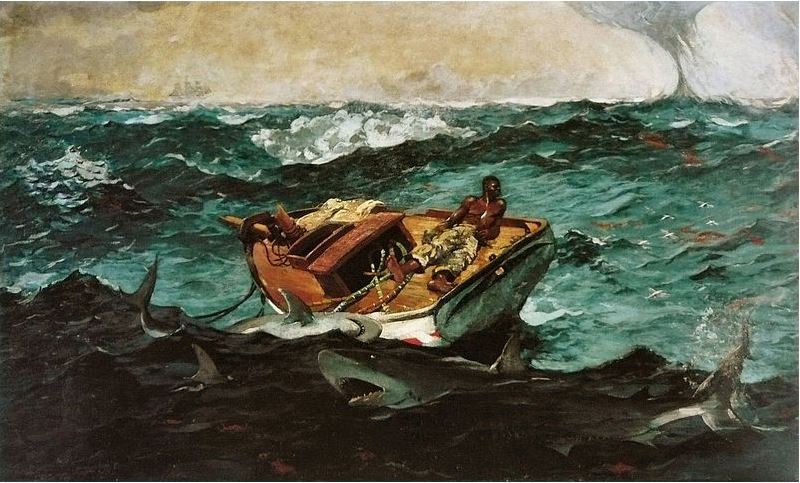
Winslow Homer’s painting titled The Gulf Stream is one that accurately shows the picturesque, yet terrifying nature of sea voyages. The painting, completed in 1899, depicts a single man inside a rudderless boat as it drifts along the ocean current amidst a swarm of hungry sharks.
The painting is a grim reminder that life at sea has a considerable level of risk, at any point, but many art critics and enthusiasts have long praised this work for its level of symbolism and detail.
The man in the boat is undoubtedly riding along the Gulf Stream, which is a strong Atlantic current that many sailors credited for bringing ships to and from certain parts of the Caribbean.
With only a few stalks of sugarcane to sustain him, the man appears to be hopelessly lost, unaware of the schooner sailing miles away in the distance to the left of the painting.
5. Impression, Sunrise – Claude Monet
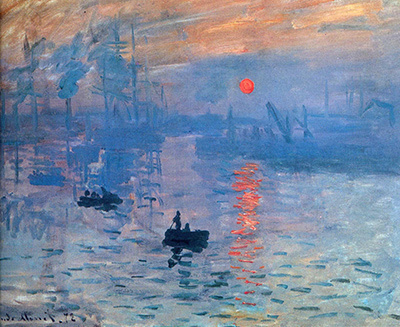
Claude Monet was famous for his ability to paint scenes in a manner that highlighted the many different colors and hues that made up the natural world.
His work titled Impression, Sunrise was done in the classic impressionist style that he was so often known for. This particular painting was first exhibited in 1874 and shows a serene depiction of a harbor at Le Havre.
Monet’s work garnered much attention for his subtle changes and uses of soft coloration to portray the first glint of light shining in the morning sun.
Rather than the large boats being the central focus of the painting, the smaller vessels are shown as being propelled by a single oar over the sparkling water.
6. The Monk by the Sea – Caspar David Friedrich
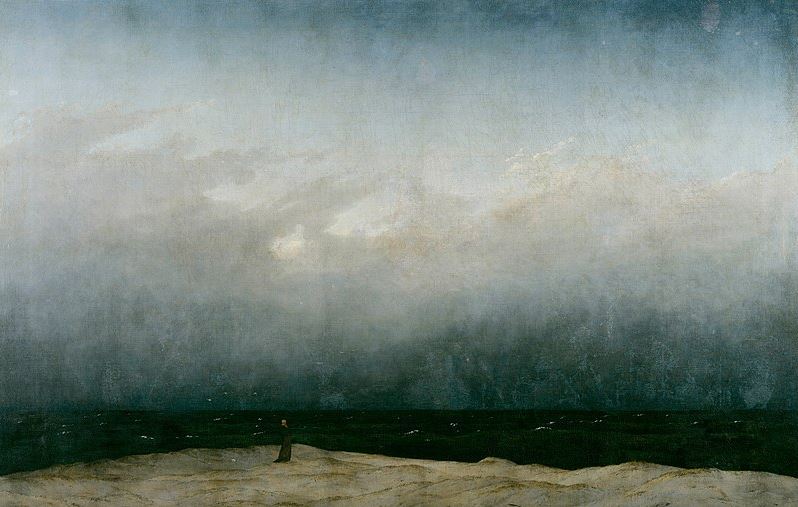
Many times, the ocean appears to blend into the sky and the horizon is disguised by clouds or fog. Caspar David Friedrich’s painting titled The Monk by the Sea is a beautiful depiction of an ocean-side scene that emphasizes the vastness of both nature and God.
This work was painted sometime between 1808 and 1810 and is known as one of the most famous German works from the time period.
Also Read: Famous Beach Paintings
The painting shows a lone monk standing along the sea shore, looking out into the seemingly endless ocean waves before him. The sky takes up most of the canvas while only a small sliver of the land and sea below are visible.
This is thought to indicate the unimaginable nature of the almighty despite our small, finite minds.
7. The Raft of the Medusa – Theodore Gericault
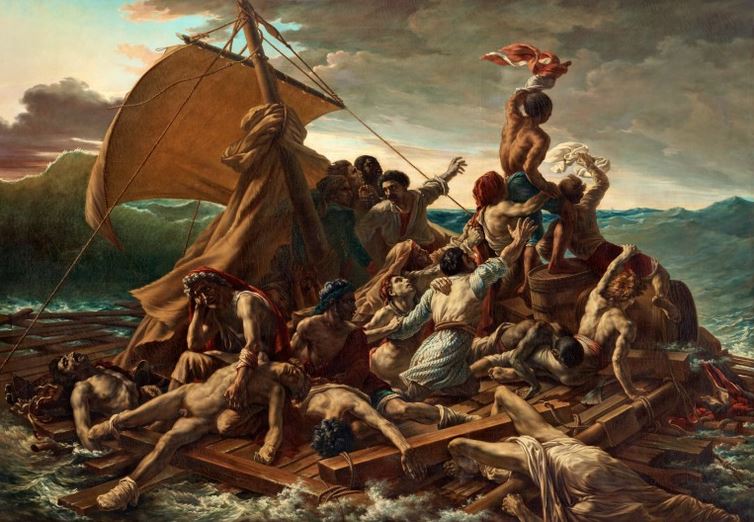
One of the most well-known French seascape paintings is Theodore Géricault’s The Raft of the Medusa, which was done in 1819. It is one of the most iconic French Romanticism paintings in history and is based on a famous shipwreck that happened off the coast of Senegal in 1816.
The artist heavily researched the incident before putting brush to canvas and took a considerable amount of time thinking about just how he would portray the grim reality of being lost at sea.
Drawing inspiration from two survivors of the shipwreck, Géricault painted a scene that captured a more hopeful outlook than what is actually recorded of the incident.
The surviving sailors of the French Royal Navy frigate told of fighting among the survivors and being forced to resort to cannibalism in the end. This painting centers on the hopeful, yet desperate nature of being stuck at sea.
8. Becalmed off Halfway Rock – Fitz Hugh Lane
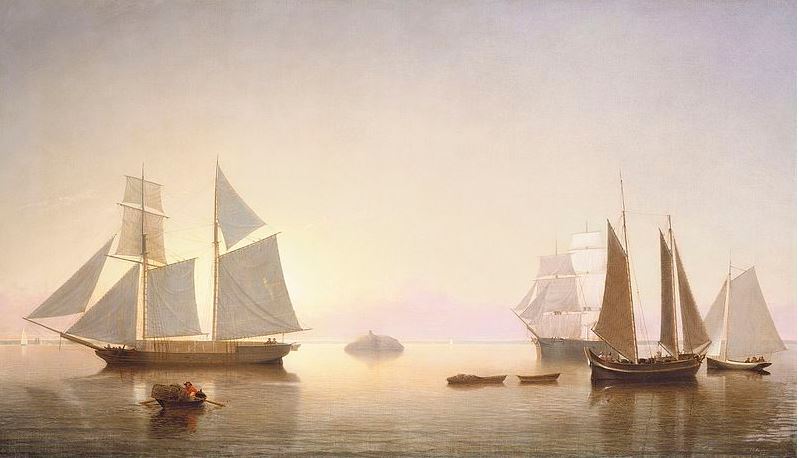
Painting the sea’s unique reflective nature is often considered one of the most difficult aspects of seascapes that many artists struggle to accurately portray.
No artist captured this characteristic more strikingly than Fitz Hugh Lane in his 1860 work titled Becalmed off Halfway Rock.
Also Read: Lighthouse Paintings
This painting depicts a scene from the New England coast sometime around the 1840’s. Sailors from that time were well-acquainted with a large rock formation that jutted out of the sea nearly halfway between Boston and Cape Ann.
This painting depicts ships lingering near the rock in a calm, almost inviting scene that features a number of warm colors.
9. La Terrace de Sainte Adresse – Claude Monet
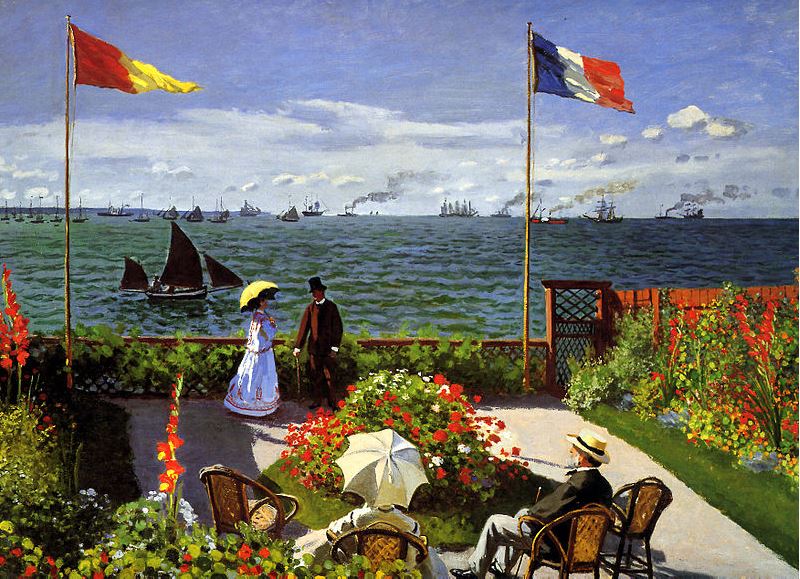
Claude Monet is known to have spent a considerable amount of time near Le Havre, a port city in France that’s known for its bustling shipping scene that often features a wide array of vessels coming and going.
The artist famously portrayed this coastal landmark in his painting titled La Terrace de Sainte Adresse in 1867.
This painting is praised by art lovers and critics for Monet’s masterful ability to capture the bright sunlight as it illuminates the vast expanse of the ocean waters near Le Havre.
The distant horizon is dotted with a variety of sailing vessels and others that were powered by more modern means during the mid 1800’s.
Monet’s ability to include vibrant, lush greenery along with the deep ocean blue is part of what makes this painting so remarkably famous, especially to those who adore French artwork.
10. Snow Storm – Steam-Boat off a Harbour’s Mouth – J.M.W Turner
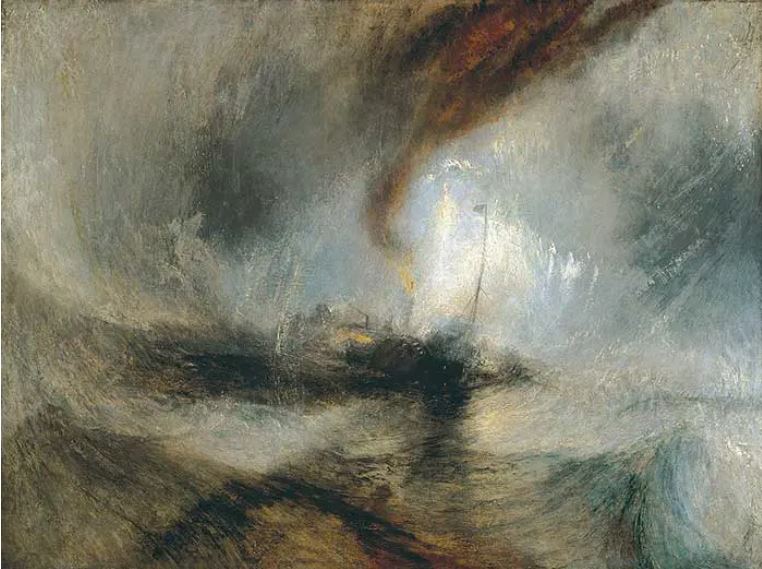
Storms are one of the most feared aspects of an oceanic voyage, but they were an inescapable reality for sailors in 1824. J.M.W. Turner painted his work titled Snow Storm during that year and managed to portray the strangely beautiful, yet violent nature of storms on the open ocean.
The painting depicts the swirling winds churning the sea into a choppy nightmare for sailors who had to endure such terrifying realities.
As with most of his oil paintings it uses only the slightest of textures raised from the canvas to give a real depth to the crashing ocean.
This abstract work largely invokes a sense of the overwhelming force that often accompanies storms at sea.

